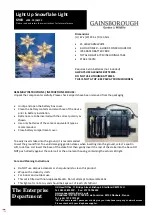
2
Safety, performance, and dependability have been given
top priority in the design of your petrol pole pruner.
INTENDED USE
The petrol pole pruner is only intended for use outdoors.
For safety reasons, the product must be adequately
controlled by using two-handed operation.
The product is designed for cutting and pruning of small
limbs and branches whose diameter is less than or equal
to the bar length, and are located high in the tree while the
operator maintains a steady footing on the ground. The
product is designed to be extended to a maximum length
of 2.7 m. Do not exceed this working length.
It is not intended to be used while climbing or as a
conventional chainsaw for close quarter limbing and
pruning of material at ground level.
Do not use the product for any other purpose.
GENERAL SAFETY WARNINGS
WARNING
For safe operation, read and understand all
instructions before using the product.
Follow all
safety instructions, information on correct working
posture, the need for rest periods, and changing working
positions. Failure to follow all safety instructions listed
below, can result in serious personal injury.
READ ALL INSTRUCTIONS
■
Do not allow children or untrained individuals to use
the product.
■
Never let anyone use the product who has not received
adequate instructions in the product’s proper use. This
applies to rentals as well as privately owned products
and also to the power head it is attached to.
■
Always wear safety glasses with side shields.
Everyday glasses have only impact resistant lenses.
They are NOT safety glasses. Following this rule will
reduce the risk of eye injury.
■
Product users in some states, must comply with fire
prevention regulations. The product is equipped with
a spark arrestor; however, other user requirements
may apply. Check with your federal, state, or local
authorities.
■
Wear eye, hearing, and head protection when
operating the product. Hearing protection may restrict
the operator’s ability to hear warning sounds, pay
particular attention to potential hazards around and
inside the working area.
■
Wear heavy-long pants, boots, and gloves. Do not
wear loose fitting clothing, short pants, or go barefoot.
Do not wear jewellery of any kind.
■
Heavy protective clothing may increase operator
fatigue, which could lead to heat stroke. During
weather that is hot and humid, heavy work should be
scheduled for early morning or late afternoon hours
when temperatures are cooler.
■
Never operate the product on the operator’s left side.
■
Secure long hair above shoulder level to prevent
entanglement in moving parts.
■
Keep all bystanders, children, and pets at least 15 m
away. Bystanders should be encouraged to wear eye
protection. If you are approached, stop the engine and
cutting attachment. In the case of bladed units, there is
the added risk of injury to bystanders from being struck
with the moving blade in the event of a blade thrust or
other unexpected reaction of the saw.
■
Do not operate the product when you are tired, ill, or
under the influence of alcohol, drugs, or medication.
■
Do not operate in poor lighting. The operator needs
clear unrestricted vision to identify potential hazards.
■
Keep firm footing and balance. Do not overreach.
Overreaching can result in loss of balance or exposure
to hot surfaces.
■
Keep all parts of your body away from any moving
part.
■
To avoid hot surfaces, never operate the product with
the bottom of the engine above waist level.
■
Do not touch area around the muffler or cylinder of the
product. These parts get hot from operation. Failure
to heed this warning could result in possible serious
personal injury.
■
Carry the pruner with the engine stopped, the guide
bar and saw chain to the rear, scabbard on the guide
bar and saw chain, and the muffler away from your
body.
■
Always stop the engine before making any
adjustments.
■
Inspect the product before each use for loose
fasteners, fuel leaks, etc. Replace any damaged parts
before use.
■
Mix and store fuel in a container approved for petrol.
■
Mix fuel outdoors where there are no sparks or flames.
Wipe up any fuel spillage. Move 9 m away from
refueling site before starting engine.
■
Stop the engine and allow to cool down before
refueling or storing the product.
■
Allow the engine to cool, empty the fuel tank, and
secure the product from moving before transporting in
a vehicle.
■
Stop the engine. Make sure all moving parts have
come to a complete stop:
●
before servicing
●
before leaving the product unattended


































